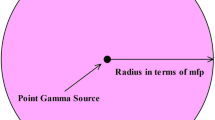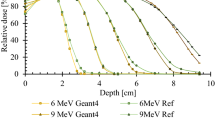Abstract
Using photons in therapeutic and diagnostic medicine requires accurate computation of their attenuation coefficients in human tissues. The buildup factor, a multiplicative coefficient quantifying the ratio of scattered to primary photons, measures the degree of violation of the Beer–Lambert law. In this study, the gamma-ray isotropic point source buildup factors, specifically, the energy absorption buildup factor (EABF) and exposure buildup factor, are estimated. The computational methods used include the geometric progression fitting method and simulation using the Geant4 (version 10.4) Monte Carlo simulation toolkit. The buildup factors of 30 human tissues were evaluated in an energy range of 0.015–15 MeV for penetration depths up to 100 mean free paths (mfp). At all penetration depths, it was observed that the EABF seems to be independent of the mfp at a photon energy of 1.5 MeV and also independent of the equivalent atomic number (\(Z_{\text{eq}}\)) in the photon energy range of 1.5–15 MeV. However, the buildup factors were inversely proportional to \(Z_{\text{eq}}\) for energies below 1.5 MeV. Moreover, the Geant4 simulations of the EABF of water were in agreement with the available standard data. (The deviations were less than 5%.) The buildup factors evaluated in the present study could be useful for controlling human exposure to radiation.






Similar content being viewed by others
References
F.O. Ogundare, I.O. Olarinoye, R.I. Obed., Estimation of patients’ organ and conceptus doses from selected x-ray examinations in two Nigeria x-ray centers. Radiat. Prot. Dosim. 132(4), 395–402 (2009). https://doi.org/10.1093/rpd/ncn317
K.S. Mann, T. Korkut, Gamma-ray buildup factors study for deep penetration in some silicates. Ann. Nucl. Energy 51, 81–93 (2013). https://doi.org/10.1016/j.anucene.2012.08.024
S.P. Singh, T. Singh, P. Kaur, Variation of energy absorption buildup factors with incident photon energy and penetration depth for some commonly used solvents. Ann. Nucl. Energy 35, 1093–1097 (2008). https://doi.org/10.1016/j.anucene.2007.10.007
D. Sardari, A. Abbaspour, S. Baradaran et al., Estimation of gamma- and X-ray photons buildup factor in soft tissue with Monte Carlo method. Appl. Radiat. Isot. 67, 1438–1440 (2009). https://doi.org/10.1016/j.apradiso.2009.02.033
A. Shimizu, H. Hirayama, Calculation of gamma-ray buildup factors up to depths of 100 mfp by the method of invariant embedding, (II) improved treatment of bremsstrahlung. J. Nucl. Sci. Technol. 40, 192–200 (2003). https://doi.org/10.3327/jnst.40.192
Y. Harima, Y. Sakamoto, S. Tanaka et al., Validity of the geometric progression formula in approximating gamma ray buildup factors. Nucl. Sci. Eng. 94, 24–35 (1986). https://doi.org/10.13182/NSE86-A17113
M. Kurudirek, Y. Kurucu, Estimation of energy absorption buildup factors of some human tissues at energies relevant to brachytherapy and external beam radiotherapy. Int. J. Radiat. Biol. Sep 17, 1–27 (2019). https://doi.org/10.1080/09553002.2019.1665217
B. Mehmet, M. Kurudirek, Radiological properties of healthy, carcinoma and equivalent breast tissues for photon and charged particle interactions. Int. J. Radiat. Biol. 94(1), 70–78 (2018). https://doi.org/10.1080/09553002.2018.1403057
American Nuclear Society, Gamma Ray Attenuation Coefficient and Buildup Factors for Engineering Materials. Report ANSI/ANS-6.4.3, USA (1991)
S. Agostinelli, J. Allison, K. Amako et al., Geant4-a simulation toolkit. NIMA 506(3), 250–303 (2003). https://doi.org/10.1016/S0168-9002(03)01368-8
J. Allison, K. Amako, J. Apostolakis et al., Recent developments in Geant4. NIMA 835(1), 186–225 (2016). https://doi.org/10.1016/j.nima.2016.06.125
C.H. Kim, S.H. Choi, J.H. Jeong et al., HDRK-Man: a whole-body voxel model based on high-resolution color slice images of a Korean adult male cadaver. Phys. Med. Biol. 53(15), 4093–4106 (2008). https://doi.org/10.1088/0031-9155/53/15/006
A. Alfuraih, O. Kadri, K. Alzimami, Investigation of SPECT/CT cardiac imaging using Geant4. Nucl. Sci. Tech. 29, 7 (2018). https://doi.org/10.1007/s41365-018-0435-8
O. Kadri, K. Manai, A. Alfuraih, Monte Carlo study of the cardiac absorbed dose during x-ray examination of and adult patient. Radiat. Prot. Dosim. 171(4), 431–437 (2016). https://doi.org/10.1093/rpd/ncv429
M.J. Berger, J.H. Hubbell, XCOM: Photon Cross Sections on a Personal Computer. NBSIR 87-3597 (National Bureau of Standards, Washington, 1987). https://doi.org/10.2172/6016002
D.R. White, Tissue substitutes in experimental radiation physics. Med. Phys. 5(6), 467–479 (1978). https://doi.org/10.1118/1.594456
L. Gerward, N. Guilbert, K.B. Jensen et al., WinXCom: a program for calculating x-ray attenuation coefficients. Radiat. Phys. Chem. 71, 653–654 (2004). https://doi.org/10.1016/j.radphyschem.2004.04.040
M. Kurudirek, Y. Ozdemir, Energy absorption and exposure buildup factors for some polymers and tissue substitute materials: photon energy, penetration depth and chemical composition dependence. J. Radiol. Prot. 31, 117–128 (2011). https://doi.org/10.1088/0952-4746/31/1/008
Y. Harima, An approximation of gamma-ray buildup factors by modified geometrical progression. Nucl. Sci. Eng. 83(2), 299–309 (1983). https://doi.org/10.13182/NSE83-A18222
M.J. Maron, Numerical Analysis: A Practical Approach (Macmillan, New York, 1987)
S.R. Manohara, S.M. Hanagodimath, L. Gerward, Energy absorption buildup factors of human organs and tissues at energies and penetration depths relevant for radiotherapy and diagnostics. J. Appl. Clin. Med. Phys. 12(4), 296–312 (2011). https://doi.org/10.1120/jacmp.v12i4.3557
V.P. Singh, M.E. Medhat, N.M. Badiger, Assessment of exposure buildup factors of some oxide dispersion strengthened steels applied in modern nuclear engineering and designs. Nucl. Eng. Des. 270, 90–100 (2014). https://doi.org/10.1016/j.nucengdes.2013.12.046
Y. Harima, S. Tanaka, Y. Sakamoto et al., Development of new gamma-ray buildup factor and application of shielding calculations. Nucl. Sci. Eng. 94, 24–35 (1991)
I.O. Olarinoye, Photon buildup factors for some tissues and phantom materials for penetration depths up to 100 MFP. J. Nucl. Res. Dev. 13, 57–67 (2017)
Y. Sakamoto, D.K. Trubey, Radiation Safety Information Computation Center Data Package DLC-129/ANS643, Geometric Progression. Gamma-Ray Buildup Factor Coefficients (1991)
J.H. Smith, Flux to Dose Rate Conversion Factors for Gamma Ray Exposure. JPL technical report, no. 32-439 (1963)
https://www.nist.gov/pml/x-ray-mass-attenuation-coefficients. Accessed 27 Aug 2019
Y. Harima, N. Kurosawa, Y. Sakamoto, Parameter search of geometric-progression formula for gamma-ray isotropic point source buildup factors up to depths of 100 mfp, including contribution of secondary radiations. Progr. Nucl. Sci. Technol. 4, 548–552 (2014). https://doi.org/10.15669/pnst.4.548
I. Jarrah, M.I. Radaideh, T. Kozlowski et al., Determination and validation of photon energy absorption buildup factor in human tissues using Monte Carlo simulation. Radiat. Phys. Chem. 160, 15–25 (2019). https://doi.org/10.1016/j.radphyschem.2019.03.008
H.J. Hirayama, Calculation of gamma-ray exposure buildup factors up to 40 mfp using the EGS4 Monte Carlo code with a particle splitting. J. Nucl. Sci. Technol. 32(12), 1201–1207 (1995). https://doi.org/10.3327/jnst.32.1201
M.M. Rafiei, H. Tavakoli-Anbaran, Calculation of the exposure buildup factors for x-ray photons with continuous energy spectrum using Monte Carlo code. J. Radiol. Prot. 38, 207 (2018). https://doi.org/10.1088/1361-6498/aa9cfa
Author information
Authors and Affiliations
Corresponding author
Additional information
This work was supported by the National Plan for Science, Technology and Innovation (MAARIFAH), King Abdulaziz City for Science and Technology, Kingdom of Saudi Arabia, Award Number (12-MED2516-02).
Electronic supplementary material
Below is the link to the electronic supplementary material.
Rights and permissions
About this article
Cite this article
Kadri, O., Alfuraih, A. Photon energy absorption and exposure buildup factors for deep penetration in human tissues. NUCL SCI TECH 30, 176 (2019). https://doi.org/10.1007/s41365-019-0701-4
Received:
Revised:
Accepted:
Published:
DOI: https://doi.org/10.1007/s41365-019-0701-4




